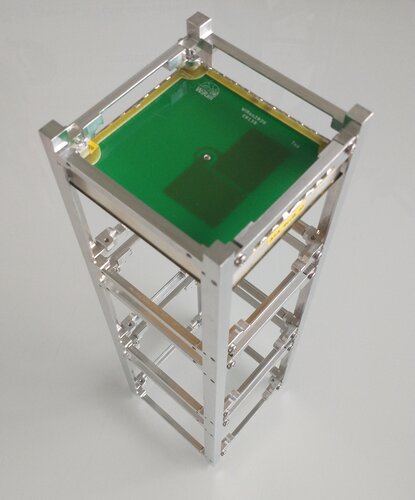
Copernical Team
InSight mission: Mars unveiled

Using information obtained from around a dozen earthquakes detected on Mars by the Very Broad Band SEIS seismometer, developed in France, the international team of NASA's InSight mission has unveiled the internal structure of Mars. The three papers published on July 23, 2021 in the journal Science, involving numerous co-authors from French institutions and laboratories, including the CNRS, the Institut de Physique du Globe de Paris, and Université de Paris, and supported in particular by the French space agency CNES and the French National Research Agency ANR, provide, for the first time, an estimate of the size of the planet's core, the thickness of its crust and the structure of its mantle, based on the analysis of seismic waves reflected and modified by interfaces in its interior. It makes this the first ever seismic exploration of the internal structure of a terrestrial planet other than Earth, and an important step towards understanding the formation and thermal evolution of Mars.
Expanding space fuels global growth in patent filings

The explosive growth in space activity in recent years is observed through a new lens in the pages of a major study of global and European space-related patents. At the same time as membership of the global space club increases, and yearly number of space launches goes on growing, a steepening of patent filings in both Europe and across the world suggest a maturing market, as key players seek to defend their intellectual assets.
Picture-frame-sized CubeSat antenna reaches orbit

An ESA project has developed satellite antenna the size of a small picture frame, intended for miniature CubeSats. Built by Polish company WiRan the antenna found its first customer as soon as it was finalised, and is already serving in space.
Space-based connectivity comes another step closer

A world in which people can connect to one another instantly and reliably through space-enabled laser communications has just come closer. A study has now identified how to create high-speed broadband in space.
Britain supports U.S. plan for deep space radar station
 A U.S. Space Force plan to position a system in Britain to monitor spacecraft up to 22,400 miles from earth drew the approval of the Royal Air Force chief.
Air Chief Marshal Sir Michael Wigston, in the United States to examine the plans, said Britain is "very interested" in hosting an element of the Deep Space Advanced Radar Capability, under development by the Space and Missile Systems
A U.S. Space Force plan to position a system in Britain to monitor spacecraft up to 22,400 miles from earth drew the approval of the Royal Air Force chief.
Air Chief Marshal Sir Michael Wigston, in the United States to examine the plans, said Britain is "very interested" in hosting an element of the Deep Space Advanced Radar Capability, under development by the Space and Missile Systems Long-period oscillations of the Sun discovered
 These motions were measured by analyzing 10 years of observations from NASA's Solar Dynamics Observatory (SDO). Using computer models, the scientists have shown that the newly discovered oscillations are resonant modes and owe their existence to the Sun's differential rotation. The oscillations will help establish novel ways to probe the Sun's interior and obtain information about our star's inn
These motions were measured by analyzing 10 years of observations from NASA's Solar Dynamics Observatory (SDO). Using computer models, the scientists have shown that the newly discovered oscillations are resonant modes and owe their existence to the Sun's differential rotation. The oscillations will help establish novel ways to probe the Sun's interior and obtain information about our star's inn SuperBIT: A low-cost balloon-borne telescope to rival Hubble
 Durham, Toronto and Princeton Universities have teamed up with NASA and the Canadian Space Agency to build a new kind of astronomical telescope. SuperBIT flies above 99.5% of the Earth's atmosphere, carried by a helium balloon the size of a football stadium. The telescope will make its operational debut next April and when deployed should obtain high-resolution images rivalling those of the Hubb
Durham, Toronto and Princeton Universities have teamed up with NASA and the Canadian Space Agency to build a new kind of astronomical telescope. SuperBIT flies above 99.5% of the Earth's atmosphere, carried by a helium balloon the size of a football stadium. The telescope will make its operational debut next April and when deployed should obtain high-resolution images rivalling those of the Hubb Planetary shields will buckle under stellar winds from their dying stars
 Any life identified on planets orbiting white dwarf stars almost certainly evolved after the star's death, says a new study led by the University of Warwick that reveals the consequences of the intense and furious stellar winds that will batter a planet as its star is dying. The research is published in Monthly Notices of the Royal Astronomical Society, and lead author Dr Dimitri Veras will pres
Any life identified on planets orbiting white dwarf stars almost certainly evolved after the star's death, says a new study led by the University of Warwick that reveals the consequences of the intense and furious stellar winds that will batter a planet as its star is dying. The research is published in Monthly Notices of the Royal Astronomical Society, and lead author Dr Dimitri Veras will pres Manipulating magnets in the quest for fusion
 After decades of plasma physics research, Senior Research Scientist Brian LaBombard is taking on magnets for MIT's new fusion effort.
"You get the high field, you get the performance."
Senior Research Scientist Brian LaBombard is summarizing what might be considered a guiding philosophy behind designing and engineering fusion devices at MIT's Plasma Science and Fusion Center (PSFC). Begin
After decades of plasma physics research, Senior Research Scientist Brian LaBombard is taking on magnets for MIT's new fusion effort.
"You get the high field, you get the performance."
Senior Research Scientist Brian LaBombard is summarizing what might be considered a guiding philosophy behind designing and engineering fusion devices at MIT's Plasma Science and Fusion Center (PSFC). Begin Astrophysicist outlines plans for the gravitational wave observatory on the moon
 Vanderbilt astrophysicist Karan Jani has led a series of studies that make the first case for a gravitational wave infrastructure on the surface of the moon. The experiment, dubbed Gravitational-Wave Lunar Observatory for Cosmology, uses the moon's environment and geocentric orbit to analyze mergers of black holes, neuron stars and dark matter candidates within almost 70 percent of the entire ob
Vanderbilt astrophysicist Karan Jani has led a series of studies that make the first case for a gravitational wave infrastructure on the surface of the moon. The experiment, dubbed Gravitational-Wave Lunar Observatory for Cosmology, uses the moon's environment and geocentric orbit to analyze mergers of black holes, neuron stars and dark matter candidates within almost 70 percent of the entire ob 